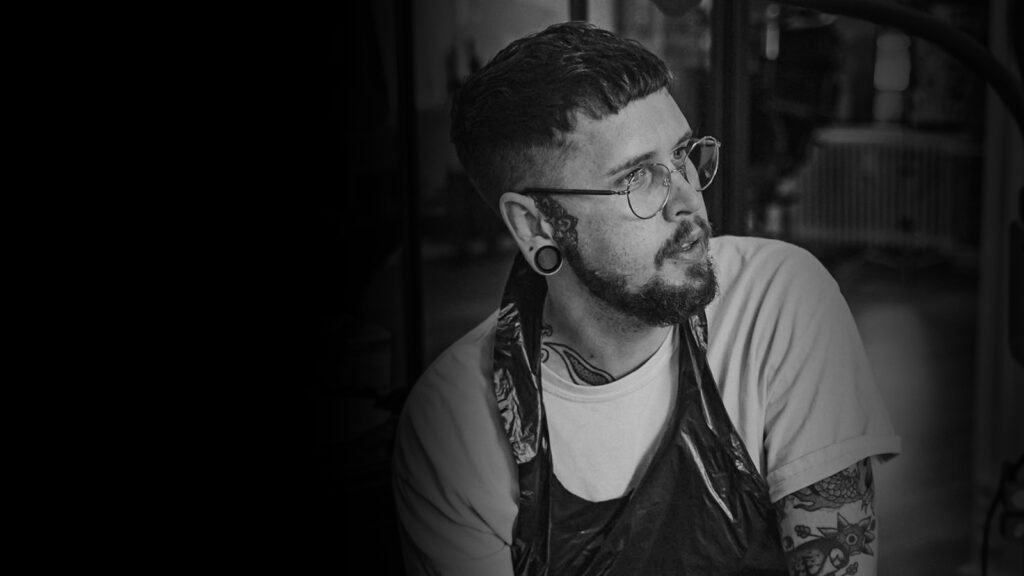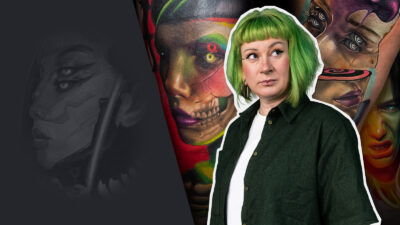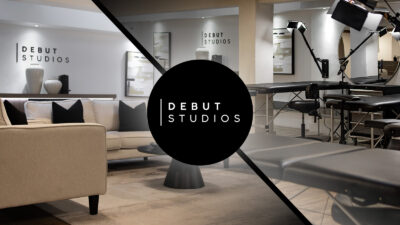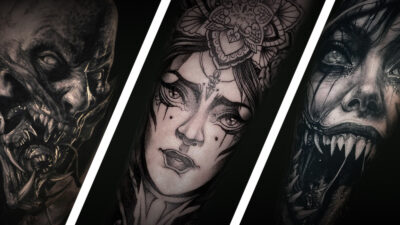Norwegian tattoo artist and co-owner of the Dropout Collective in Copenhagen, Ruben Langsted creates black and grey work inspired by classic art and architecture.
From the beginnings of his career to becoming a world-renowned artist with complete artistic control over his work, Ruben’s tattoos have become better, larger, and more intricate over time.
We asked him about his art background, how he became a tattoo artist, and the seminars he runs with fellow Dropout Collective artist Chris Henriksen!
What was your life like before you became a tattoo artist?
Before I was a tattoo artist, I studied Digital Drawing and Visual Communication in Norway to earn my bachelor’s degree. Then I met my girlfriend and moved to Denmark to stay with her! When I came here, I worked in a kindergarten as an assistant and loved it. If I weren’t a tattoo artist, I would definitely work in teaching.
Who really inspired you when you first started tattooing?
The kindergarten I worked at was pretty close to the red light district of Copenhagen, meaning I would see all kinds of people every day on my way to work. There were also tons of tattoo parlours in the area, and this was the first time I was really exposed to tattoos, as they were rare where I grew up in Norway. Now I could see tattoos everywhere - good ones too! This was about the same time as the popular tattoo TV shows started airing, and the interest in tattooing accelerated at that time for sure.
How would you describe your tattoo art style?
My style is based in black and grey realism, and my themes vary from natural to Greek/Roman and other cultures. The work I do is always large-scale and often covers vast amounts of the body. Still, my work doesn’t seem too dramatic, or vulgar in anyway – it’s mellow and easily readable.
How long have you been tattooing?
I started my apprenticeship around November 2012, so 10 years!
Can you talk us through your tattoo workstation?
I’ve tried a lot of different equipment, machines, needles, etc to end up with the ones I use now. The Bishop Power Wand 5.0 Liner is my go-to machine, and is an absolute beast. It has a strong punch and will saturate really quick, but it’s important to take into consideration the voltage so you don’t overwork the skin with the combination of such a powerful machine and bugpin needle configurations.
Speaking of, my needles are from the amazing KWADRON team. I have a regular setup of 0.25/07 round liners, 0.25/09 curved mags and 0.25/13 curved mag. The 13 is my favourite, and I use it for most of my work recently. Make sure you check out the new premium Sublime cartridges which are mind-blowingly good.
I also use Hustle Butter for both the tattoo and healing process. I even use it at home for everyday needs - with small kids at home there’s always a little bruise that needs some extra care!
What is your favourite theme to tattoo?
Anything where I can go in-depth and learn something new! It can sometimes be like traveling in time when I get to learn more about the history behind the references.
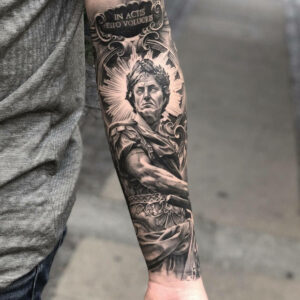
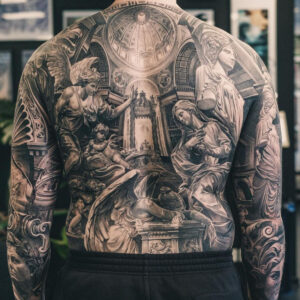
Do you start from a design or from the body part you’re working on?
Always from the shape of the body. It’s the most important part for me to see the area we will cover and talk about the vision with my client before we start any design whatsoever. We can agree to a theme, but I won’t do any design before the client arrives.
This is to understand the client’s boundaries and create a long-term vision. I wouldn’t be able to do this over an email correspondence, as it’s a conclusion that I reach in my first conversation with clients. For example, if someone is booked in for a sleeve, but they know already that there will be a chest piece or backpiece next time, then the best idea might be to work in a different area than originally agreed on, depending on the reference pictures we find.
Did you ever study classics or architecture?
I had 6 years in school where we had art history classes, and architecture has always inspired me. I’m lucky to live in an amazing city with old buildings. In general, there are an amazing number of references in a lot of European cities. Whenever I travel, I will stop to look at corners and windows, and will immediately get an idea of where on the body that would go!
You do some very large-scale pieces, have you ever done a full body?
I would say almost all my clients are slowly getting their full body done. Aren’t we all! In 2020 I did a full torso, back, front and both sleeves in about 7 months on a very dedicated client. I also did a 90% bodysuit during the first few years of my career.
How long were you tattooing before you felt comfortable insisting on complete artistic freedom?
I felt comfortable quite quickly, but with tattooing, sometimes the more you know, the less you know. I feel comfortable still, but there is definitively an awareness to my designs I’ve worked for years to fully understand. After I started having apprentices, I had to shape my knowledge into something more concrete, which is when I started to understand myself and why I do certain things the way I do. Understanding why I do something is fundamental in developing my mindset - it keeps me on my toes and from getting too complacent. Teaching has always been important to me because of this. It gives me so much to discuss with peers who are interested in learning.
What are your clients usually like?
My clients are most often men, in the range of 25-40 years old. I find I relate a lot to my clients, in that family and business is important. They are interested in art itself more than the average person, and are at a place in their life where quality is important. My clients are extremely dedicated and trust me to do my thing. I am forever grateful to each one that I have in my chair!
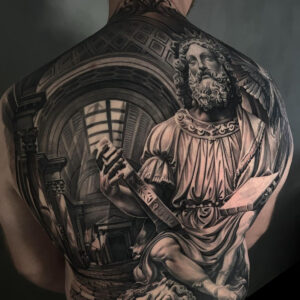
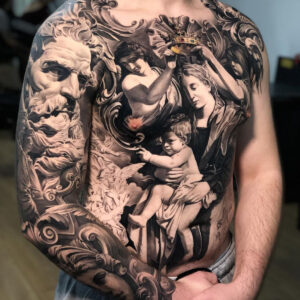
Have you ever done a collaboration tattoo?
Yes, I have! The most exciting one is a small collaboration I did with my dear colleague Ester Tarabal, she did the crown on my client Alexandar, who got a full torso by me. The crown stands out as the only colour part of the piece and I’m super happy with how it fits in. I normally don’t enjoy collaborations too much, other than the social aspect of course.
Who works at Dropout Collective with you?
You can check out all our artists on our IG page @dropout_collective or on dropout.dk! In general, I believe we have a strong team with some of the most dedicated artists in Denmark.
Is it stressful to run your own studio and tattoo at the same time?
Yes, sure. It’s a good feeling to be busy, and I can’t complain about that. Thankfully, the artists working at Dropout are amazing at helping out with day-to-day chores. It’s also way easier doing this together with Chris, who has the same ambitions and dedication as myself.
Why is it a “Collective” rather than a studio?
When we first talked about opening a studio together, we had a common idea to create a space where inspiring artists would thrive under the right conditions. All our artists are independent, and not reliant on the shop, other than to contribute their knowledge and motivate each other to create something better every day. This is also important since we don’t have managers or receptionists to do everything for us. It’s important that everyone contributes. Basically, Dropout Collective is made by artists for artists.
What’s the furthest someone has travelled to get tattooed by you?
I would say about 60% of my clients are from the US, then the remaining in Europe or Denmark. I’ve had clients all the way from Hawaii and Australia. Pretty crazy, and I’m humbled every time someone is that dedicated. It keeps me on my toes and makes me always push for better results.
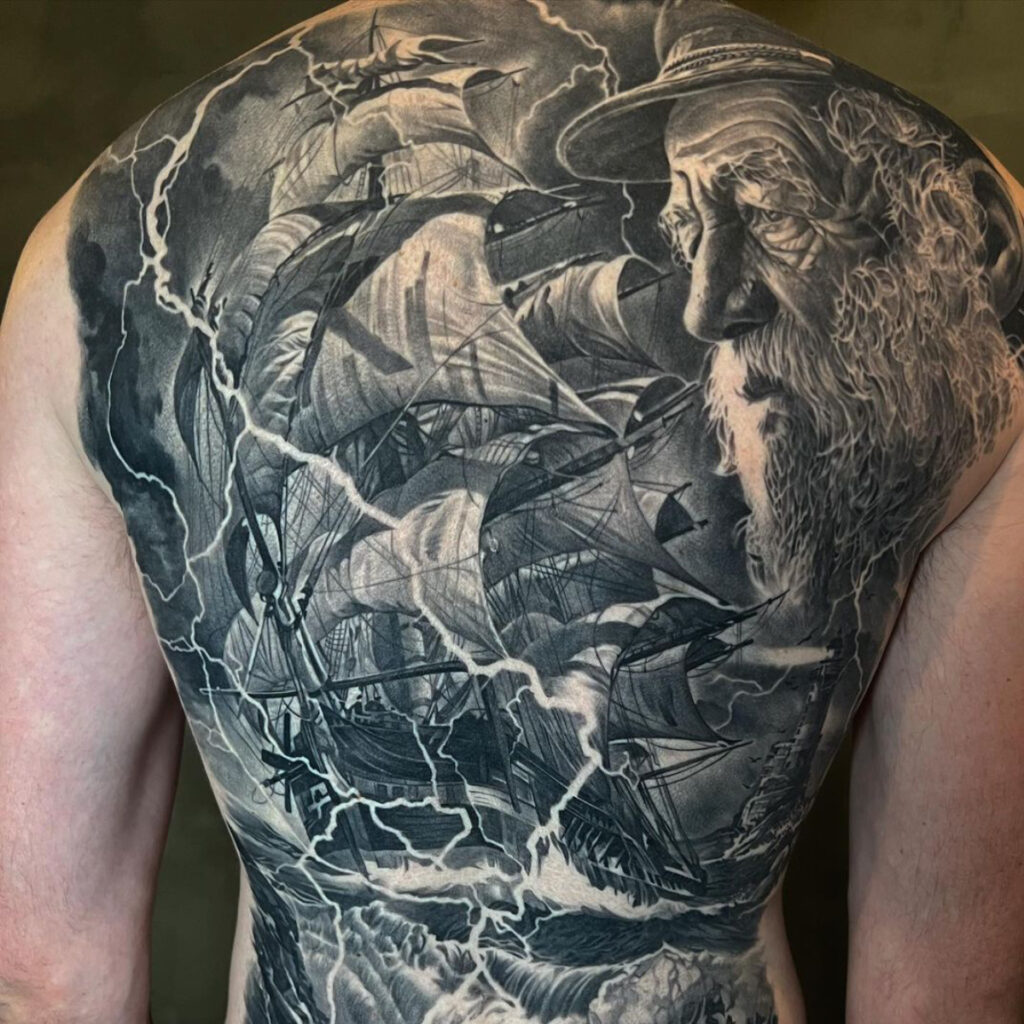
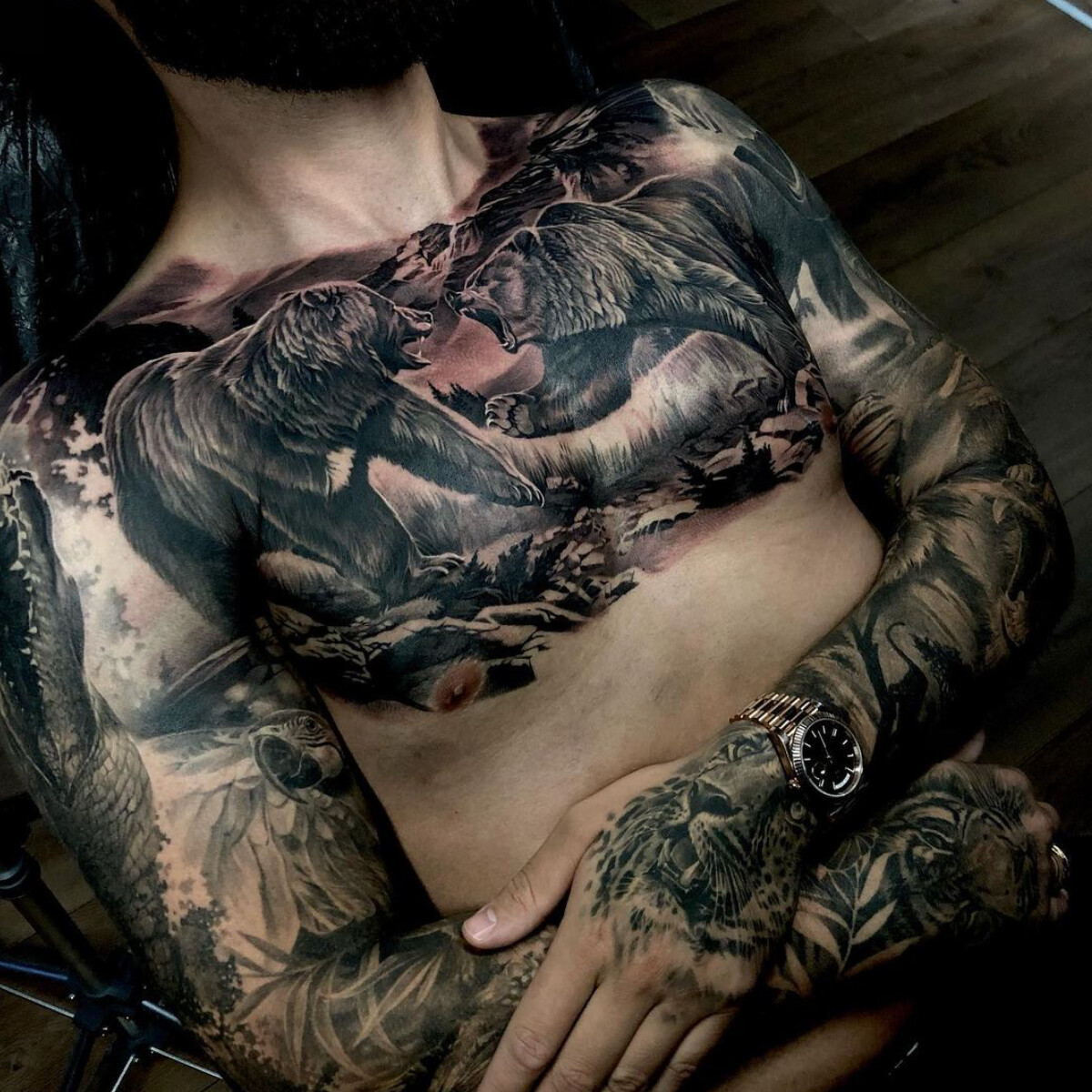
What did you cover in the seminar that you and Chris Henriksen held this year?
This was the first time I’ve had an intertwined seminar, meaning we would go through two vastly different styles, mindsets, and approaches at the same time. It was a long seminar, about 7 hours. We covered pretty much everything from understanding our background to execution, finding the right references, overall design, and mapping techniques, plus much more. I hope to take the seminars online next year!
Do you ever experiment with colour?
I’m working on one World of Warcraft leg sleeve in full colour, because this is an old client I’ve known for a super long time. I never look forward to working on it, but when we are actually doing the tattoo it’s somewhat fun anyway!
How important is it for a client to trust their artist, and how can artists help build that trust?
I mean it’s the most important thing, period. If I don’t feel like I have the clients trust in me to do my style or ideas, I would rather just not tattoo them. I make this clear in my booking form online. If people don’t agree to this, that’s fair enough - they can book in with someone else, and everyone is happy!
Do you have any experience you’d like to impart to apprentices?
Look up! Travel, and understand that good knowledge isn’t always as accessible as it seems. Online seminars and YouTube videos on “how to be a tattoo artist in 1 month” or “how to earn a quick buck” are just malarkey, and it’s the wrong way to approach tattooing in my opinion. Tattooing is about mileage - focus on where you are right now and enjoy the bumpy ride.
Second, don’t focus too much on social media. Your focus should be on understanding your tools, the techniques and being a good artist for the clients in your chair. This way you will build a solid and loyal clientele quickly. Compare yourself with yourself.
Third, be humble. Drop your headphones and always be available for your colleagues and client. Take tattooing seriously, appreciate that you are on the road to learn the best fucking job in the world.
How many tattoos do you have, and do you have a favourite?
Funnily enough, I only have traditional colour tattoos. There is something about the old school mentality I really connect with and want to bring into black and grey. I got my torso and most of my legs done, but still need to fill in a few blanks!
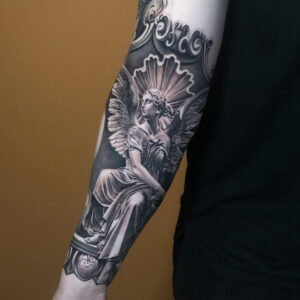
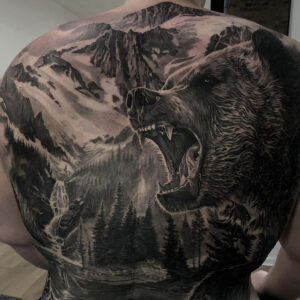
What’s the tattoo scene like in Copenhagen?
The scene here is not as good as I know it could be. There’s tons of talent and a lot of shops with very good artists, but we need something more, like a convention with integrity. Hopefully someone picks up on that soon.
What’s the best thing about your job?
My co-workers, and the freedom that comes with being my own boss. There is just so much to say about tattooing, I often rejoice over the fact that I am getting paid to have so much fun! There is also the aspect of self-fulfilment and the fact that no one can stop you from becoming better - other than yourself of course. The fact that everything is in my own hands is both empowering and terrifying at the same time.
What do you like to do in your free time?
I spend as much time with my family as I can. They are my motivation. In the evenings I also like to be a nerd, playing video games – it’s always been an escape for me, not that my life is suffocating! In warmer seasons, my wife and I will work in the garden, which is something I enjoy a lot.
Are you heading to any conventions in 2023?
I haven’t booked any conventions yet, but there’s plans for the US in 2023 for sure!
What’s next for Ruben Langsted?
This year has been the year I learned the most about running a shop. There are just so many aspects to handling artists, clients, inventory and administration that I now feel is going steady. Now it’s about making the studio as good as it can be. I don’t necessarily think “big moves” is the way, my foundation is Dropout Collective and my family; that’s where I need to put my focus.
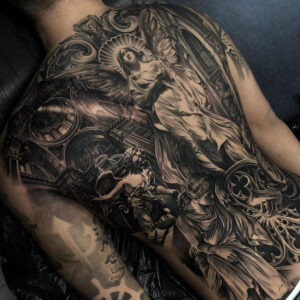
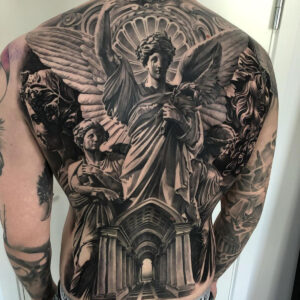
We hope you’ve enjoyed our chat with Copenhagen-based black and grey expert Ruben Langsted - make sure to follow his work on Instagram or Facebook!
